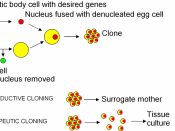We have heard a great deal of public outcry ever since Scotland first cloned a sheep a few years back. Now there are countries which are cloning cattle to provide beef for their nation (Golden). These realities have made many people incredibly frightened at the prospect of science using the information to clone human beings. While this is a very legitimate argument, for we do not need to run the risk of cloning human beings and opening ourselves up to the prospects that could only be imagined in a frightening science fiction novel, we do need to understand that cloning is a very unique scientific process which should be allowed due to the fact that it can improve the lives of many people throughout the entire world.
In first examining the reality of cloning, we turn to illustrating the problems that are associated with the procedure. We all clearly understand the moral issues that lie behind the arguments against cloning live creatures, especially human beings, one of which states that "What will it mean if we move from a social practice of welcoming the children who are born to us to a practice of selecting them and their characteristics, either by cloning or by modifying the genome in vitro before implantation?" (Wheeler 14).
But what of this scientific knowledge is not fully understood yet? What do we really know of the cloning process and the eventual outcomes of cloning live creatures? The first creature to be cloned was, as mentioned previously, a sheep in Scotland. They named her Molly. Since her cloning it has been discovered that she is older genetically than she is chronologically. In an article in Newsweek the authors state that "Her telomeres--the protective ends of chromosomes--are shortened. They wear down every time a cell replicates, and...


